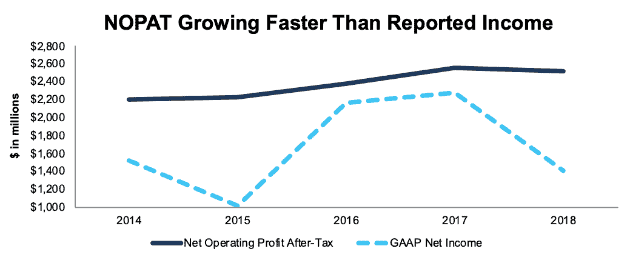Eight new stocks make February’s Exec Comp Aligned with ROIC Model Portfolio, available to members as of February 15, 2019.
The success of this Model Portfolio highlights the value of our Robo-Analyst technology[1], which scales our forensic accounting expertise (featured in Barron’s) across thousands of stocks.
This Model Portfolio only includes stocks that earn an Attractive or Very Attractive rating and align executive compensation with improving ROIC. We think this combination provides a uniquely well-screened list of long ideas because return on invested capital (ROIC) is the primary driver of shareholder value creation.[2]
New Stock Feature for February: Kimberly Clark Corporation (KMB: $119/share)
Kimberly-Clark Corp (KMB) is the featured stock in February’s Exec Comp Aligned with ROIC Model Portfolio. We highlighted KMB as a Long Idea in November 2017 and as a featured stock in the Safest Dividend Yields Model Portfolio in April 2018. Since the April 2018 report, KMB has outperformed the market (15% vs. S&P +4%) and remains undervalued.
Since 2014, KMB has grown after-tax profit (NOPAT) by 3% compounded annually while reported profits have declined by 2% compounded annually. Over the long-term, KMB has grown NOPAT by 3% compounded annually since 1998.
True profit growth has been fueled by rising NOPAT margins, which are up from 11% in 2014 to 14% in 2018. KMB’s return on invested capital (ROIC) has improved from 12% in 2014 to 15% in 2018.
Figure 1: KMB’s NOPAT and GAAP Net Income Since 2014

Sources: New Constructs, LLC and company filings
The disconnect in Figure 1 between GAAP net income and NOPAT in 2018 comes primarily from $973 million (5% of revenue) in non-recurring restructuring charges that must be removed from reported earnings to calculate the true profitability of the firm.
Executive Compensation Plan Helps Drive Shareholder Value Creation
KMB executives receive long-term equity compensation in the form of performance based restricted stock units (RSU’s). These awards are tied to the achievement of two goals, 3-year average return on invested capital and annual net sales growth, each of which is weighted at 50%. RSU’s made up 54% of the CEO’s pay in 2017 (most recent year data is available) so it should come as no surprise that KMB has improved ROIC in recent year – executives’ bonuses depend on it.
The focus on improving ROIC aligns the interests of executives and shareholders, helps to ensure prudent stewardship of capital, and lower the risk of investing in the business. KMB has averaged a 13% ROIC since 1998 and earned a 15% ROIC in 2018.
KMB Remains Undervalued
At its current price of $119/share, KMB has a price-to-economic book value (PEBV) ratio of 1.0. This ratio means the market expects KMB’s NOPAT will never grow from current levels. This expectation seems pessimistic given KMB’s ability to grow NOPAT by 3% compounded annually over the past two decades.
If KMB can maintain 2018 NOPAT margins (15%) and grow NOPAT by just 3% compounded annually over the next decade, the stock is worth $156/share today – a 31% upside. See the math behind this dynamic DCF scenario here.
Critical Details Found in Financial Filings by Our Robo-Analyst Technology
As investors focus more on fundamental research, research automation technology is needed to analyze all the critical financial details in financial filings. Below are specifics on the adjustments we make based on Robo-Analyst findings in Kimberly-Clark Corp’s 2018 10-K:
Income Statement: we made $1.8 billion of adjustments, with a net effect of removing $1.1 billion in non-operating expense (6% of revenue). You can see all the adjustments made to KMB’s income statement here.
Balance Sheet: we made $9.3 billion of adjustments to calculate invested capital with a net increase of $8.4 billion. One of the largest adjustments was $3.3 billion for other comprehensive income. This adjustment represented 42% of reported net assets. You can see all the adjustments made to KMB’s balance sheet here.
Valuation: we made $9.8 billion of adjustments with a net effect of decreasing shareholder value by $9.8 billion. There were no adjustments that increased shareholder value. Apart from $8.2 billion in total debt, which includes $468 million of operating leases, the largest adjustment to shareholder value was $962 million in underfunded pensions. This pension adjustment represents 2% of KMB’s market cap. Despite the net decrease in shareholder value, KMB remains undervalued.
This article originally published on February 21, 2019.
Disclosure: David Trainer, Kyle Guske II, Sam McBride and Andrew Gallagher receive no compensation to write about any specific stock, style, or theme.
Follow us on Twitter, Facebook, LinkedIn, and StockTwits for real-time alerts on all our research.
[1] Harvard Business School features the powerful impact of our research automation technology in the case New Constructs: Disrupting Fundamental Analysis with Robo-Analysts.
[2] Ernst & Young’s recent white paper “Getting ROIC Right” demonstrates the superiority of our stock research and analytics.
